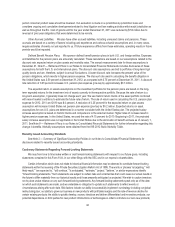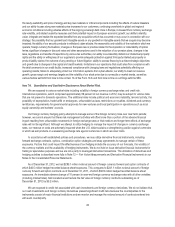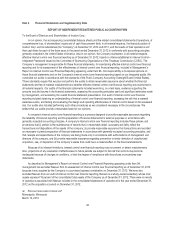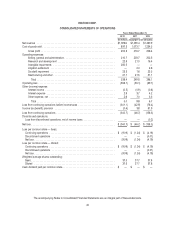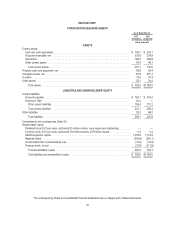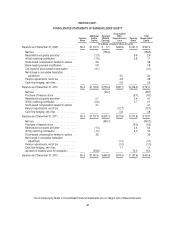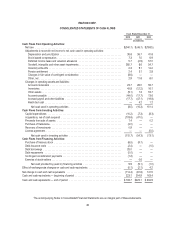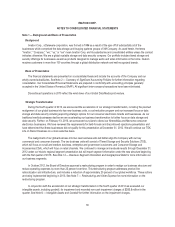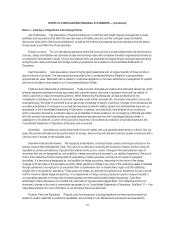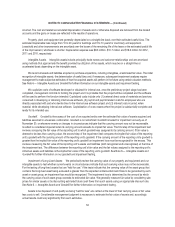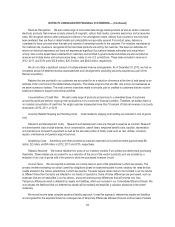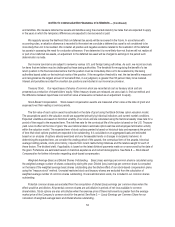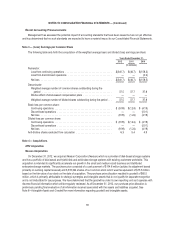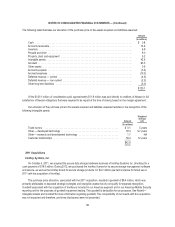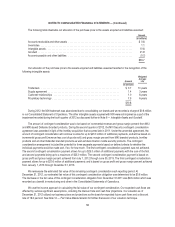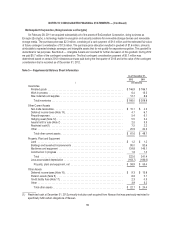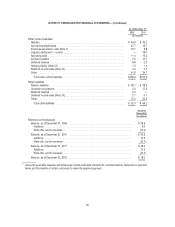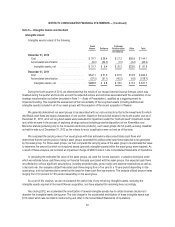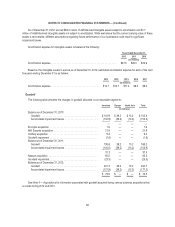Memorex 2012 Annual Report Download - page 55
Download and view the complete annual report
Please find page 55 of the 2012 Memorex annual report below. You can navigate through the pages in the report by either clicking on the pages listed below, or by using the keyword search tool below to find specific information within the annual report.NOTES TO CONSOLIDATED FINANCIAL STATEMENTS — (Continued)
incurred. The cost and related accumulated depreciation of assets sold or otherwise disposed are removed from the related
accounts and the gains or losses are reflected in the results of operations.
Property, plant and equipment are generally depreciated on a straight-line basis over their estimated useful lives. The
estimated depreciable lives range from 10 to 20 years for buildings and 5 to 10 years for machinery and equipment.
Leasehold and other improvements are amortized over the lesser of the remaining life of the lease or the estimated useful life
of the improvement, whichever is shorter. Depreciation expense was $8.3 million, $10.7 million and $18.2 million for 2012,
2011 and 2010, respectively.
Intangible Assets. Intangible assets include principally trade names and customer relationships and are amortized
using methods that approximate the benefit provided by utilization of the assets, which may be on a straight-line or
accelerated basis depending on the intangible asset.
We record all assets and liabilities acquired in purchase acquisitions, including intangibles, at estimated fair value. The initial
recognition of intangible assets, the determination of useful lives and, if necessary, subsequent impairment analyses require
management to make subjective estimates of how the acquired assets will perform in the future using certain valuation methods.
SeeNote6—Intangible Assets and Goodwill for further information on our intangible assets and impairment testing.
We capitalize costs of software developed or obtained for internal use, once the preliminary project stage has been
completed, management commits to funding the project and it is probable that the project will be completed and the software
will be used to perform the function intended. Capitalized costs include only (1) external direct costs of materials and services
consumed in developing or obtaining internal-use software, (2) payroll and payroll-related costs for employees who are
directly associated with and who devote time to the internal-use software project and (3) interest costs incurred, when
material, while developing internal-use software. Capitalization of costs ceases when the project is substantially complete and
ready for its intended use.
Goodwill. Goodwill is the excess of the cost of an acquired entity over the estimated fair value of assets acquired and
liabilities assumed in a business combination. Goodwill is not amortized. Goodwill is tested for impairment annually as of
November 30, or whenever events or changes in circumstances indicate that the carrying amount may not be recoverable.
Goodwill is considered impaired when its carrying amount exceeds its implied fair value. The first step of the impairment test
involves comparing the fair value of the reporting unit to which goodwill was assigned to its carrying amount. If fair value is
deemed to be less than carrying value, the second step of the impairment test compares the implied fair value of the reporting
unit’s goodwill with the carrying amount of the reporting unit’s goodwill. If the carrying amount of the reporting unit’s goodwill is
greater than the implied fair value of the reporting unit’s goodwill an impairment loss must be recognized for the excess. This
involves measuring the fair value of the reporting unit’s assets and liabilities (both recognized and unrecognized) at the time of
the impairment test. The difference between the reporting unit’s fair value and the fair values assigned to the reporting unit’s
individual assets and liabilities is the implied fair value of the reporting unit’s goodwill. See Note 6 — Intangible Assets and
Goodwill for further information on our goodwill and impairment testing.
Impairment of Long-Lived Assets. We periodically review the carrying value of our property and equipment and our
intangible assets to test whether current events or circumstances indicate that such carrying value may not be recoverable.
For the testing of long-lived assets that are “held for use,” if the tests indicate that the carrying value of the asset group that
contains the long-lived asset being evaluated is greater than the expected undiscounted cash flows to be generated by such
asset or asset group, an impairment loss would be recognized. The impairment loss is determined by the amount by which
the carrying value of such asset group exceeds its estimated fair value. We generally measure fair value by considering sale
prices for similar assets or by discounting estimated future cash flows from such assets using an appropriate discount rate.
See Note 6 — Intangible Assets and Goodwill for further information on impairment testing.
Assets to be disposed of and qualify as being “held for sale” are carried at the lower of their carrying value or fair value
less costs to sell. Considerable management judgment is necessary to estimate the fair value of assets and, accordingly,
actual results could vary significantly from such estimates.
52


